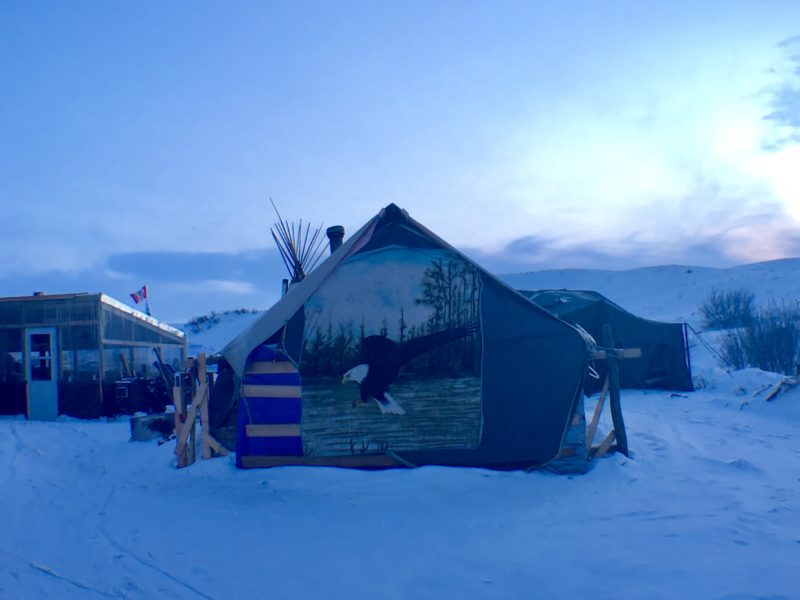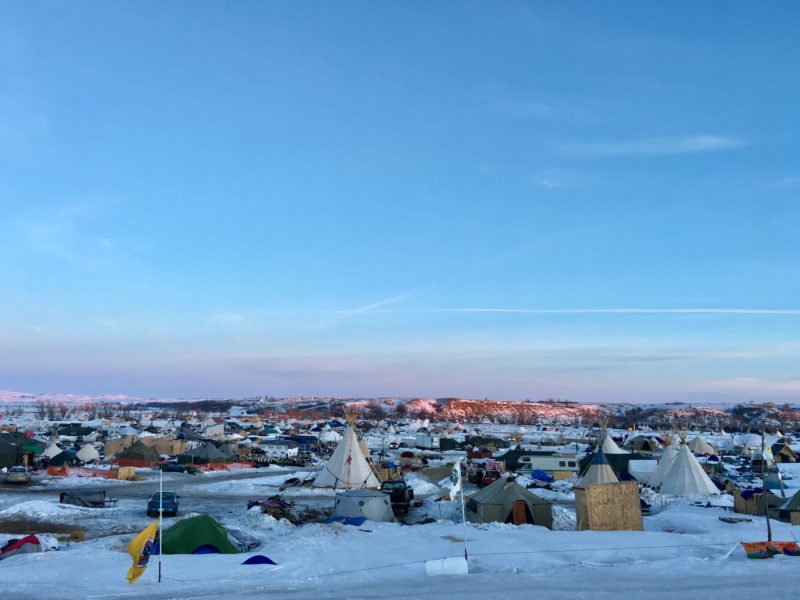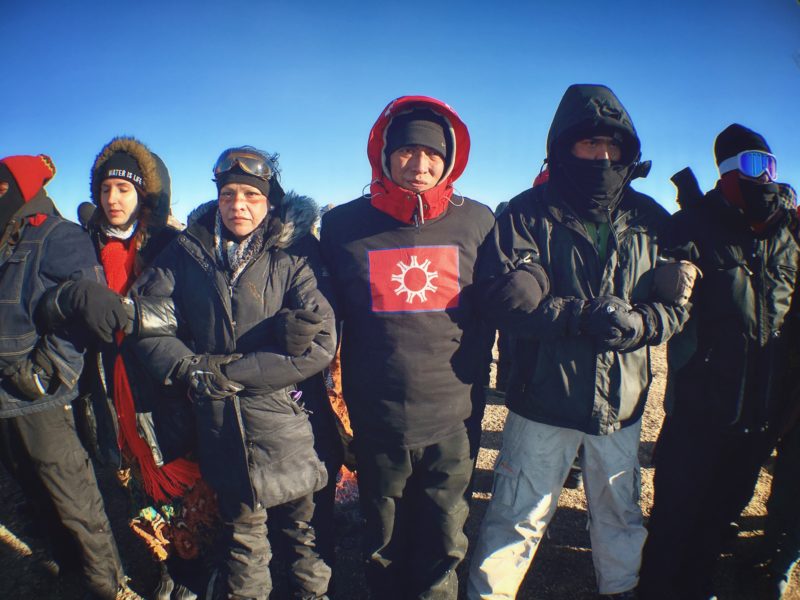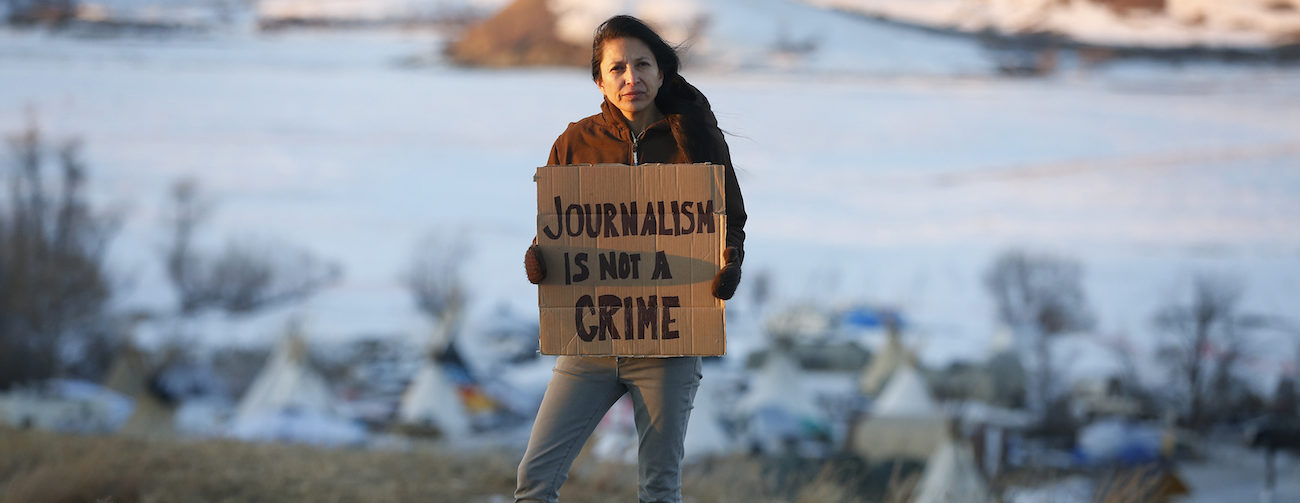Sign up for the daily CJR newsletter.
The day the Department of the Army granted the final easement for the construction of the Dakota Access pipeline, I hopped into my pickup truck—a beater that I rent from a local—and drove straight to the Sacred Stone Camp. Darkness fell slowly over the yurt-village of campers, who were only then learning the news.
Nearly a year earlier, a Cheyenne River Sioux environmentalist had erected the first teepee at Sacred Stone as part of a mass resistance campaign to stop the crude-oil line, known as the “black snake.” Since then, the camp had become the backdrop for reactionary Facebook Live feeds whenever the ongoing indigenous struggle flared. LaDonna Tamakawastewin Allard, who owns part of the camp property, was often the star attraction. In some videos, Allard stood with teams of protesters (who call themselves “water protectors,”) and called on the world “to stand with Standing Rock,” the reservation that straddles the states of North and South Dakota. Some of the people around her stared, silent. A few held fists in the air.
On this night, the people I saw seemed untroubled. A man named Benji had just arrived to the camp earlier in the week. When I told him construction of the line was on its way to resuming, he shrugged his shoulders then combed his fingers through his thick auburn beard. “I guess it’s to be expected,” he said.
Anyone who has followed the battle over the Dakota Access Pipeline knew that, under President Donald J. Trump, there would likely come a day when the controversial energy project would resume. During his first week in office, Trump took executive action to advance the permitting process of the $3.8 billion pipeline.
Despite the odd complacency I encountered that night at Sacred Stone, and after speaking with several more “Benjis,” I wasn’t taken aback. In chronicling the resistance movement—which, at one point, drew as many as 14,000 people to Standing Rock—there has always been this sort of mellow vibe, especially at times that might alarm others.

A structure inside the Sacred Stone Camp, the first encampment of the nearly year- long resistance movement against the Dakota Access pipeline. Photo by Jenni Monet.
It was a dynamic that few of my journalism colleagues could understand from a distance.
“What’s the reaction from the camps?” asked one message I received that night, as journalists considered whether they should return to the reservation. I’ve written about the movement at Standing Rock for nearly six months, and had embedded myself there in December. Since then, I’d grown used to receiving these kinds of messages. “Are more people on their way?” “Are protests planned?!?!”
My colleagues’ messages always seemed to carry more urgency than anything I felt at the camps. And I detected their discouragement each time I replied that there was probably more action in the cities that they were texting me from than what was happening where I stood, near the border of the reservation.
Yet while covering the resistance movement at Standing Rock—an unprecedented moment in the history of the indigenous rights struggle—I have watched, at times in agony, at how the media has handled this story. Had it not been for Trump—for his sensationalized campaigning and his dramatic actions taken during his first weeks in office—the months-long standoff on the reservation might have been a major news item time and again. As police forces intensified their response to water protectors who insisted they were unarmed, scenes from Standing Rock came to resemble those from Black Lives Matter protests, many of which received greater news coverage. And as water protectors encountered chemical sprays, rubber-coated bullets, MRAP tanks and concussion grenades, the sentiment at Standing Rock became that it would take someone getting killed before it mattered to the mainstream. An elite press has watched the conflict through an unsteady lens.
ON FEBRUARY 1, I was gathering interviews, and taking photographs of campers who had established a village atop historic treaty territory when police began arresting people. I complied with police requests to show my media credentials, and was asked to stand behind police lines and a semi-circle of teepees that police would soon order to be razed. I stood back even farther, several feet away from where the mass arrests were taking place; I didn’t have my helmet or protective eyewear. As police disbanded a locked-arm circle of prayer demonstrators, an officer approached me and told me to leave the bluff.
“Walk or you’re going to jail,” he said.
I was mulling over deadlines and reporting schedules when I realized, midway down the hill, that the officer who ordered me to leave had followed me. I implied that I was a journalist by telling the officer that other media remained on top of the hill, referring to two men I saw filming with DSLR cameras—one of whom, a white man, can be seen in my photographs taken before my arrest.
“I was standing back. I was respectful,” I told the officer. Still, I became one of 74 people detained that day, and now face charges of criminal trespassing and engaging in a riot, Class B misdemeanors that could result in jail time and fines.
At least eight journalists have been arrested while covering the Dakota Access pipeline. None of their stories have received the sort of media attention given to Amy Goodman, the “Democracy Now!” host for whom an arrest warrant was issued in September by the Morton County Sheriff’s Department. The charges against Goodman, who had her standing as a journalist challenged by a prosecutor, were rejected in October by a judge. They are the same charges I face now.

The Oceti Sakowin Camp, the main site where thousands gathered in the movement to try and stop the Dakota Access pipeline. Photo by Jenni Monet.
Goodman “spent her time in jail knowing she had the backing of her show, its lawyers, and millions of viewers,” wrote Tracy Loeffelholz-Dunn, editorial director of Yes! Magazine, a publication I routinely write for. “It was a national event on the evening news.” Loeffelholz-Dunn posted an editorial days after my arrest that includes a letter template with the names and addresses of the North Dakota attorney general and the Morton County district attorney, and calls on them to drop the charges against me.
Still, I haven’t felt assured of support from the media. The Los Angeles Times has been the sole member of the legacy press to cover my arrest. That coverage is due, in large part, to the prodding of Sandy Tolan, with whom I’ve spent months reporting on the standoff at Standing Rock. But tucked inside the article, a few scrolls down, was a video screen-grab of Goodman. When I messaged Tolan after the piece went live on the Times’ website, I told him I would not be sharing it with my readers.
“Not that I’m vain… but WOW,” I wrote to Tolan. “They put a photo [of] Amy Goodman, a white well-known journalist in that piece, instead of me?” Tolan understood, and explained to me that the issue had more to do with the size and shape of my headshot; it was square, and the headline art needed to be horizontal.
None of this was Tolan’s fault: He’s a freelancer like me, far removed from the newsroom where stories are packaged. I asked that the report include my picture and, after much back and forth, my request was granted that night. I thanked Tolan for understanding.
“Please take my policing of how Indigenous Peoples are represented *and treated* by the established media as no slam on you,” I messaged him. “This is what I do when I’m not reporting. I set the record straight—and I’m unapologetic about it.”
WHEN JOURNALISTS WERE ARRESTED during the protests in Ferguson, Missouri, their plight was reported by The New York Times, Time magazine, CNN, and so on. By comparison, the media that stepped up to share my Standing Rock struggle has largely been independent—fitting, perhaps, since these niche newsrooms invested early in chronicling this moment among the Lakota Sioux and their allies.
The story of my arrest is just one example of how major news outlets have treated the resistance movement at Standing Rock as an afterthought. More often, the media has been reactionary, as in moments when extreme actions of policing could no longer be ignored. On November 20, after police doused dozens of demonstrators with water in sub-freezing temperatures at a protest near the main camp, I stayed up all night writing about the media blackout. Even that harrowing story took two days to make the front page of The New York Times.
That relative inattention is why I decided to write about my arrest. I take pride in the fact that I have reported on the movement at Standing Rock from multiple points of view, and with a concerted effort to represent all sides in conflicts. I’ve formed strong working relationships at both the county and state level, and reached out to leading community voices away from the reservation. Because I am a journalist of indigenous origin, and because much of my work has been steeped in writing about indigenous-themed struggles like Standing Rock, I have often felt I’ve had to overcompensate in my role as a journalist as a way to disprove notions of activism.

Protesters known as water protectors lock arms in preparation of a police raid during a Feb. 01 demonstration near the Standing Rock Sioux reservation. Photo by Jenni Monet.
Turning inward at a time when the protest movement seems to be toppling around me, though, has been distracting and frustrating. It’s made me feel awkward for shifting the lens away from this epic conflict and onto myself, even for a moment. As the standoff slowly winds down and turns to the courts, though, I find comfort in knowing that perhaps my arrest—just one among 700 or so others—comes at time when people need to be informed about new directions in the movement. The public relies on reporters to uncover patterns of misinformation and questionable tactics by police. Those patterns have not only played out in my arrest, but in the months-long militarized protection of a corporate energy project.
I could walk away and allow my charges to play out in court. I could sit back and let police lie to local media about how I never presented my press credentials when asked when, in fact, I did. And I could just keep it to myself that white women I was jailed with told me they were not strip-searched upon being booked, but that Native American women like me were. But silence helps no one where inequality exists. That’s why I stayed at Standing Rock when the live trucks left. And that’s why I’ll continue to report on one of the greatest indigenous struggles in modern times.
Pipeline construction has resumed, and the camps are dispersing. Journalists are parachuting in again, and some of their coverage over-hypes the American military veterans who have returned to support water protectors. The local voice of the community, grown weary of the movement, has been ignored by the out-of-town press.
So this is the last time I will write about my arrest. I’ll get back to reporting on the other lives impacted by this struggle in southern North Dakota. And I’ll continue to monitor my relationships with Morton County and state officials, and hope I’m not reading into things too sensitively when I see press releases inviting “Bismarck-area reporters” to events and wonder whether this kind of language is intended to exclude me.
Has America ever needed a media defender more than now? Help us by joining CJR today.







